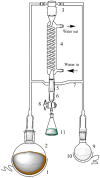Chemical Composition and Antimicrobial Activities of Artemisia argyi Lévl. et Vant Essential Oils Extracted by Simultaneous Distillation-Extraction, Subcritical Extraction and Hydrodistillation
- PMID: 30700013
- PMCID: PMC6384757
- DOI: 10.3390/molecules24030483
Chemical Composition and Antimicrobial Activities of Artemisia argyi Lévl. et Vant Essential Oils Extracted by Simultaneous Distillation-Extraction, Subcritical Extraction and Hydrodistillation
Abstract
Artemisia argyi Lévl. et Vant essential oil could be used as a good antimicrobial flavouring agent and applied in the food industry. In this study, three methods, including simultaneous distillation-extraction (SDE), subcritical extraction and hydrodistillation, were applied to extract A. argyi essential oil. Compared with subcritical extraction (1%) and hydrodistillation (0.5%), SDE gave a higher yield (1.2%). Components of the essential oils were analysed with gas chromatography-mass spectrometry (GC-MS), and the most abundant ingredients were caryophyllene oxide, neointermedeol, borneol, α-thujone and β-caryophyllene. These five components accounted for 82.93%, 40.90% and 40.33% for SDE, subcritical extraction, and hydrodistillation, respectively. Based on agar disc diffusion and minimum inhibitory concentration (MIC) assays, SDE oil showed a significant inhibitory effect towards Listeria monocytogenes, Escherichia coli, Proteus vulgaris, Salmonella enteritidis and Aspergillus niger. Furthermore, electron microscope observations (SEM) confirmed that SDE oil could obviously deform cell morphology and destroy the structure of cell walls. Performances showed that SDE was a promising process for extracting A. argyi essential oil with both high yield and antimicrobial activity.
Keywords: Artemisia argyi; antimicrobial activity; essential oil; simultaneous distillation extraction.
Conflict of interest statement
No potential conflict of interest was reported by the authors.
Figures







Similar articles
-
Comparison of composition and antifungal activity of Artemisia argyi Lévl. et Vant inflorescence essential oil extracted by hydrodistillation and supercritical carbon dioxide.Nat Prod Res. 2006 Sep;20(11):992-8. doi: 10.1080/14786410600921599. Nat Prod Res. 2006. PMID: 17032625
-
The antimicrobial effect and mechanism of the Artemisia argyi essential oil against bacteria and fungus.Braz J Microbiol. 2024 Mar;55(1):727-735. doi: 10.1007/s42770-023-01172-2. Epub 2023 Nov 13. Braz J Microbiol. 2024. PMID: 37957442 Free PMC article.
-
Chemical composition of hydrodistilled essential oil of Artemisia incana (L.) Druce and antimicrobial activity against foodborne microorganisms.Chem Biodivers. 2009 Dec;6(12):2302-10. doi: 10.1002/cbdv.200800317. Chem Biodivers. 2009. PMID: 20020464
-
From longevity grass to contemporary soft gold: Explore the chemical constituents, pharmacology, and toxicology of Artemisia argyi H.Lév. & vaniot essential oil.J Ethnopharmacol. 2021 Oct 28;279:114404. doi: 10.1016/j.jep.2021.114404. Epub 2021 Jul 8. J Ethnopharmacol. 2021. PMID: 34246739 Review.
-
Review of the Chemical Composition and Biological Activities of Essential Oils from Artemisia Argyi, Artemisia Princeps, and Artemisia Montana.Curr Top Med Chem. 2023;23(16):1522-1541. doi: 10.2174/1568026623666230330152345. Curr Top Med Chem. 2023. PMID: 37638613 Review.
Cited by
-
Microbial community and fermentation characteristic of whole-crop wheat silage treated by lactic acid bacteria and Artemisia argyi during ensiling and aerobic exposure.Front Microbiol. 2022 Nov 10;13:1004495. doi: 10.3389/fmicb.2022.1004495. eCollection 2022. Front Microbiol. 2022. PMID: 36439818 Free PMC article.
-
Preparation and Properties of Chitosan Complexes Consisting of Artemisia argyi Volatile Oil Nanoemulsion.Molecules. 2025 Jan 27;30(3):585. doi: 10.3390/molecules30030585. Molecules. 2025. PMID: 39942687 Free PMC article.
-
Green Extraction of Phenolic Acids from Artemisia argyi Leaves by Tailor-Made Ternary Deep Eutectic Solvents.Molecules. 2019 Aug 5;24(15):2842. doi: 10.3390/molecules24152842. Molecules. 2019. PMID: 31387251 Free PMC article.
-
Study on the Multitarget Mechanism and Active Compounds of Essential Oil from Artemisia argyi Treating Pressure Injuries Based on Network Pharmacology.Evid Based Complement Alternat Med. 2022 Jan 19;2022:1019289. doi: 10.1155/2022/1019289. eCollection 2022. Evid Based Complement Alternat Med. 2022. PMID: 35096100 Free PMC article.
-
Phytotoxic and Antimicrobial Activities of Teucrium polium and Thymus decussatus Essential Oils Extracted Using Hydrodistillation and Microwave-Assisted Techniques.Plants (Basel). 2020 Jun 4;9(6):716. doi: 10.3390/plants9060716. Plants (Basel). 2020. PMID: 32512751 Free PMC article.
References
-
- Huang H.-C., Wang H.-F., Yih K.-H., Chang L.-Z., Chang T.-M. Dual Bioactivities of Essential Oil Extracted from the Leaves of Artemisia argyi as an Antimelanogenic versus Antioxidant Agent and Chemical Composition Analysis by GC/MS. Int. J. Mol. Sci. 2012;13:14679. doi: 10.3390/ijms131114679. - DOI - PMC - PubMed
MeSH terms
Substances
Grants and funding
LinkOut - more resources
Full Text Sources
Miscellaneous

